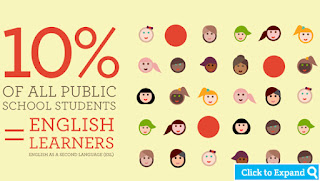Teaching ELL Students
Twice a week I tutor an ELL (Engligh Language Learner) student, SM. in literacy at a local elementary school. (I am using only my student's initials to protect their identities) SM. is in first grade, can speak English fluently, but is behind grade level in his reading and writing. SM. and I work on his alphabet, manipulation of sounds, rhyming, vocabulary, high frequency words, and any other problem areas in his reading. My interventions are highly specific to SM.'s case, planned in a lesson plan before each session, and seem to be improving SM.'s weaker areas. Every Tuesday and Thursday, I pull SM out of his classroom for one on one tutoring in attempts to help bring him up to grade level. In my classes, we have discussed how it is difficult to be behind in reading, writing, and communication due to a language barrier within the classroom. When I put myself into SM's shoes, I imagine it will difficult to grow within feeling some sort of social isolation from his peers, yet, he still has the chance to grow up in the same place as all of the other students and become accustomed to the community.
Recently, I have begun tutoring another ELL student at a high school level, which, in only two sessions, has made me come to realize that students like SM who enter this country at an elementary level have a far easier time than those who are older. My student, SH, at the local high school is an adult Somali student who is 20 years old and in the 12th grade. He arrived in October of 2015 and had never gone to school prior to coming to America. In my observations of his class which is an entirely ELL Foundations of Science class, I have found that acquiring tier 3 vocabulary words, such as specific science-only related words like atmosphere, ejecta, meteorite, and supernova, is difficult for the entire class to the point where it prevents them from understanding higher concepts. My student, SH, seemed to understand most of the concepts through illustration, yet, when it came to describing them, he would often get words confused or not know them at all. During one visit, I got to observe my student taking the speaking portion of his WIDA test, a standardized state-mandated test for English profiency of ELL students. The test is electronic, not taking into account that many of the ELL students are also internet learners as they have not had access to computers until coming to America. The test prompts the students to describe into a microphone what they see in a picture, and SH was able to identify the subjects of the images, but unable to describe them in detail. SH would make statements such as "I see two girls and a boy," or "I see a school, a car, and a runner."
Why should students who not only have little to no educational experience, but who also have difficulty describing an image in detail be expected to understand complex science terms in English? With students like SH, there is a fine line between teaching age-appropriate information and keeping the material accessible to ELL students. Although SH had not attended school prior to 2015, he is a 20 year old student, which would be inappropriate in a classroom for younger students. Students like SM, who are ELL students at an elementary level, have the benefit over students like SH in learning basic reading, phonemic awareness, spelling, vocabulary and writing that may get buried within specific subject areas at a high school level. Overall, being an ELL student is difficult in American school systems, but the older they are, the more difficult it is.


Comments
Post a Comment